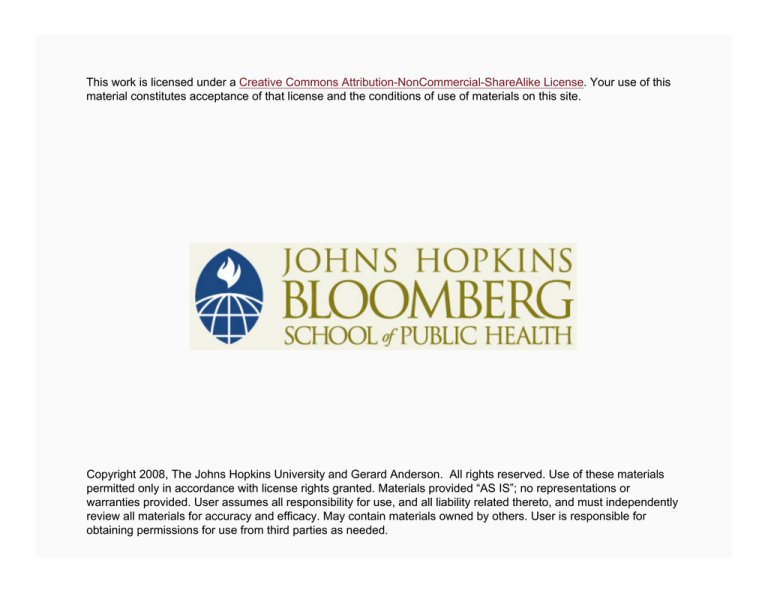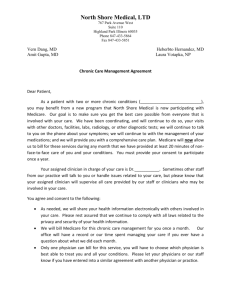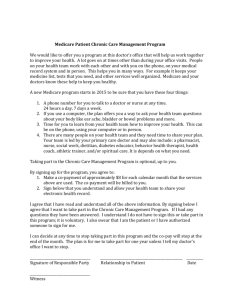
This work is licensed under a Creative Commons Attribution-NonCommercial-ShareAlike License. Your use of this
material constitutes acceptance of that license and the conditions of use of materials on this site.
Copyright 2008, The Johns Hopkins University and Gerard Anderson. All rights reserved. Use of these materials
permitted only in accordance with license rights granted. Materials provided “AS IS”; no representations or
warranties provided. User assumes all responsibility for use, and all liability related thereto, and must independently
review all materials for accuracy and efficacy. May contain materials owned by others. User is responsible for
obtaining permissions for use from third parties as needed.
Economic and Financial Considerations in Health
Policy
Gerard F. Anderson, PhD
Johns Hopkins University
Section A
Introduction to Economics
Four Fundamental Tenets of Economics
Resources are scarce relative to human wants
Resources have alternative uses
People have different priorities
Consumer knows best
4
Opportunity Costs
You have to choose because you cannot do everything at
once
You select the best alternative given budget constraints
You must make tradeoffs
5
Guns
Tradeoffs
450
400
350
300
250
200
150
100
50
0
0
1
2
3
4
Butter
6
Two Ideas Not Embraced by Economists Because They
Ignore Tradeoffs
Romantic
− We can afford it
Technical
− Best possible
7
Economists Versus Clinicians
Orientation of clinicians/public health advocates is
to achieve . . .
− Highest quality of care possible
− Health services available to meet demand
− 100% immunization rates
− No pollution
− No medical errors
8
Economists Versus Clinicians
Orientation of economist
− Social optimum
− Value of additional increment of health = cost of
resources to provide it
9
Output
Diminishing Returns
Input
10
Marginal Benefit = Marginal Cost
What is the benefit someone receives from the last dollar
invested in health?
Could the same dollar be better spent on something else and
the person would receive more benefit?
11
Demand
Term used in economics
Measures what people are willing to pay for
12
Demand Curve
P
Q
13
RAND Health Insurance Overall Results
Coinsurance Probability of Medical Use
Expenses per
Person
Free
87%
$1,019
25%
79%
$826
50%
74%
$764
95%
68%
$700
14
Some of the Factors that Influence Demand for Health Care
Illness level
Age and gender
Beliefs about medical care
Advice from providers
Income
Education
Regulations
Insurance coverage
Quality
Access
15
Section B
Tradeoffs as Viewed by Economists
Better Health or Other Goals?
One in five Americans smokes
People working in coal mines understand the danger
− Have few other options besides working in the mines
17
Prevention or Medical Care
Cancer prevention vs. cancer treatment
18
Which Medical Care Provider Is Most Effective?
What is the best (most cost effective) way to produce health?
− Physician or nurse practitioner
− Nurse practitioner or social worker
− Social worker or community health worker
− Community health worker or nurse’s aide
19
Equity/Disparities
How does income/race impact access to care/health status?
What are the most effective ways to reduce disparities and
promote equity?
20
Today or Tomorrow
Investment in improved health status vs. consumption of
medical resources
Dollars spent today versus dollars spent tomorrow
Dollars saved today versus dollars spent today
21
Discount Rate
Lives saved today vs. lives saved next year
Important for prevention
22
Identifiable vs. Statistical Lives
Known person vs. statistical person
23
Spending Tradeoffs and Health Policy
Federal government
State government
Corporations
Unions
24
Medicare and Medicaid as Percentages of the Projected
Federal Budget, 2004
Notes Available
25
Maryland State Budget: Fiscal Year 2004
Notes Available
26
Corporations
The concern is competition in international markets
− Approximately $2,000 of the price of U.S. automobiles is
for health benefits to American workers
− Approximately $1,000 of the price of European or
Japanese automobiles is for health benefits to workers
27
Unions
Corporations negotiate with unions over total compensation
package
Total compensation = wages + benefits
If health benefits increase faster than total compensation
than less money is available for wages
− Many employees do not acknowledge this tradeoff
− Bitter union negotiations over the last few years have
focused on benefits
28
Cost
Cost
Effective
Benefit
Cost Effective
Cost Benefit
29
How Do You Measure Cost?
Direct costs
Indirect costs
30
Costs from Whose Perspective?
Person
Insurer
Clinician/provider
Society
31
An Individual Person Goes to an MD —What Are the Direct
Costs?
Person—out of pocket
Insurer—benefits paid
Clinician—cost of providing treatment (payment)
Society—resources used
32
An Individual Person Goes to an MD —What Are the
Indirect Costs?
Person—time and travel
Insurer—administrative costs
Clinician/provider—none
Society—time, travel, and administrative
33
Section C
Cost-Effectiveness Analysis
When You Calculate Costs . . .
From whose perspective should the calculation be done?
What costs should be considered?
35
How Do You Measure Effectiveness?
Clinically
Quality of life
Functional level
Quality adjusted life years
Disability adjusted life years
36
How Do You Measure Benefit?
In dollar terms
What is a life worth?
What is an eye worth?
37
Cost Benefit
Both in dollar terms
Benefits in dollar terms—value of a life
38
Cost Effective
Cost in dollar terms
Effectiveness measured in some type of output (e.g., life
saved)
39
Section D
The Eightfold Path, Part I
1. Define the Problem—Financing and Delivery System
The current health care system uses an acute-care financing
and delivery system to treat chronic conditions; therefore
people with chronic conditions suffer
41
1. Define the Problem—Health Insurance
Health insurance is oriented to covering acute—not
chronic—conditions; therefore people with chronic
conditions suffer
42
1. Define the Problem—Medicare Orientation
The Medicare program is oriented to covering acute, not
chronic, conditions; therefore Medicare beneficiaries suffer
43
2. Assemble Some Evidence
What are the problems?
44
Changing Needs
1900–1950
− Infectious diseases
1950–2000
− Episodic care
2000–2050
− Chronic care
45
Growing Prevalence of Chronic Conditions
141,000,000
125,000,000
2000
2010
Data Source: Wu, Shin-Yi, and Green, Anthony. Projection of Chronic Illness Prevalence and Cost
Inflation. RAND Corporation, October 2000.
46
Medical Care Spending
Sixty percent of medical care spending is by people with
multiple chronic conditions
47
Three-quarters of Americans Believe That Access to
Care Is a Problem for People with Chronic Conditions
Percent of population believing
this is a problem
100%
90%
80%
79%
72%
74%
Access to primary care
specialist
Obtaining prescription
medications
70%
60%
50%
40%
30%
20%
10%
0%
Access to medical
specialist
Data Source: random nationwide surveys conducted by Harris Interactive and Gallup for Partnership Solutions
Note: three-fourths said that access to medical services is a problem; nine-tenths said that getting adequate
health insurance is a problem
48
Insurance Coverage
Eighty-one percent of all physicians reported that health
insurance coverage was “not sufficient to cover all the types
of care” patients with chronic conditions need
Eighty-nine percent of people report difficulty getting
adequate health insurance coverage for chronic conditions
49
Chronic Conditions and Health Care Confusion
Percentages of people with chronic conditions who answered
“sometimes” or “often” when asked how often the
following happened in the past 12 months
−
−
−
−
Been told about a possibly harmful drug-drug
interaction—54 percent
Been sent for duplicate tests or procedures—54 percent
Received different diagnoses from different clinicians—52
percent
Received contradictory medical information—45 percent
Source: Harris Survey, 2000
Notes Available
50
The Number of Unique Doctors Increases with Number
of Chronic Conditions
15.0
Amount of services utilized
13.0
10.0
7.8
6.0
4.8
5.0
3.7
1.6
0.0
0.0
1.0
2.0
3.0
4.0
Number of chronic conditions
5+
Source: Medicare SAF, 2001
51
Disease Management Rationale
Only 50 percent of practice guidelines are followed
52
Out-of-pocket spending
Out-of-Pocket Spending Increases with Numbers of
Chronic Conditions
$2,000
$1,900
$1,800
$1,700
$1,600
$1,500
$1,400
$1,300
$1,200
$1,100
$1,000
$900
$800
$700
$600
$500
$400
$300
$200
$100
$0
$1,851
$1,382
$1,052
$718
$457
$191
0
1
2
3
4
5+
Number of chronic conditions
Data Source: Medical Expenditure Survey (2000)
53
Medical Necessity
Services may be covered but denied using medical necessity
criterion
Standard should be maintaining level of functioning, not
improvement
54
Medicare Does Not Know It Is a Program for People…
With multiple chronic conditions
55
Beneficiaries with Five or More Chronic Conditions
Account for Two-thirds of Medicare Spending
1 chronic
chronic 0 condition
2 chronic
conditions
3%
conditions
1%
6%
chronic 3
conditions
10%
4 chronic
conditions
12%
5+ chronic
conditions
68%
Source: Medicare (2001) 5 percent sample
56
2. Assemble Some Evidence
What are the problems?
57
Section E
The Eightfold Path, Part II
3. Construct the Alternatives
More research
New demonstrations
New legislation
Revise regulations
59
4. Select Evaluation Criterion
Health status of Medicare beneficiaries
Aggregate Medicare spending
Out-of-pocket spending by Medicare beneficiaries
Satisfaction of Medicare beneficiaries
60
5. Project the Outcomes—Research, Demonstrations
Research and demonstrations
− Clearer understanding of problem and solutions
61
5. Project the Outcomes—Legislation
Legislation
− What is legislatively possible?
− What is most important change?
− How will change impact lives of Medicare beneficiaries?
62
5. Project the Outcomes—Regulations
Regulations
− What changes can be done using regulation?
− What are the most important changes?
− How will the regulatory changes impact the lives of
Medicare beneficiaries?
63
6. Confront the Trade-offs
What is most important and likely to succeed?
64
7. Decide—Research
Research
− Medicare will conduct research on chronic conditions
65
7. Decide—Demonstrations
Demonstrations
− Medicare will conduct demonstration to provide better
care for people with chronic illness
66
7. Decide—Legislation
Legislation
− Large population groups will be given instruction on
better care of chronic conditions
67
7. Decide—Regulations
Regulations
− Medicare will revise its definition of medical necessity
68
8. Tell Your Story
Medicare is a program for people with chronic conditions…
but does not know it
69







